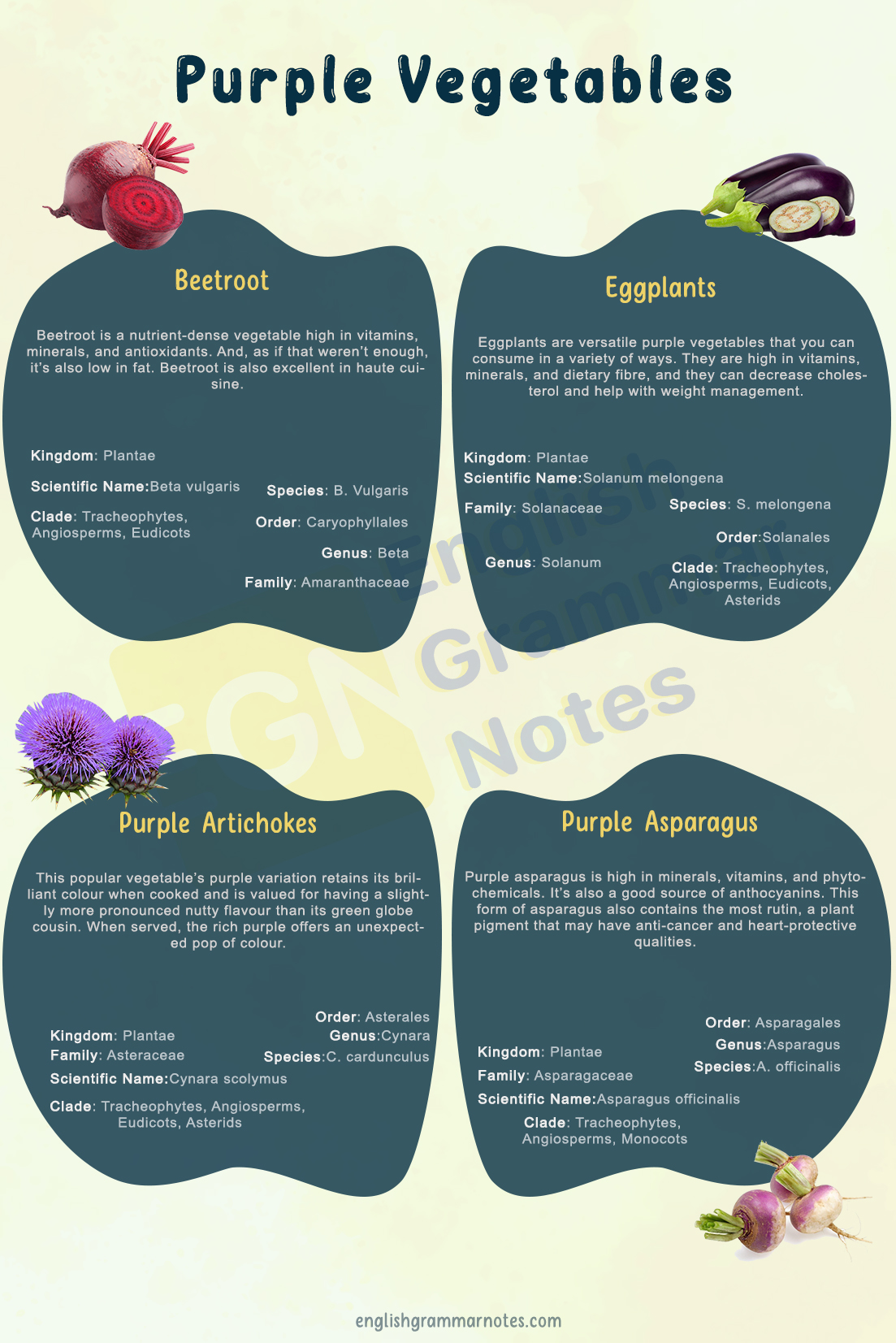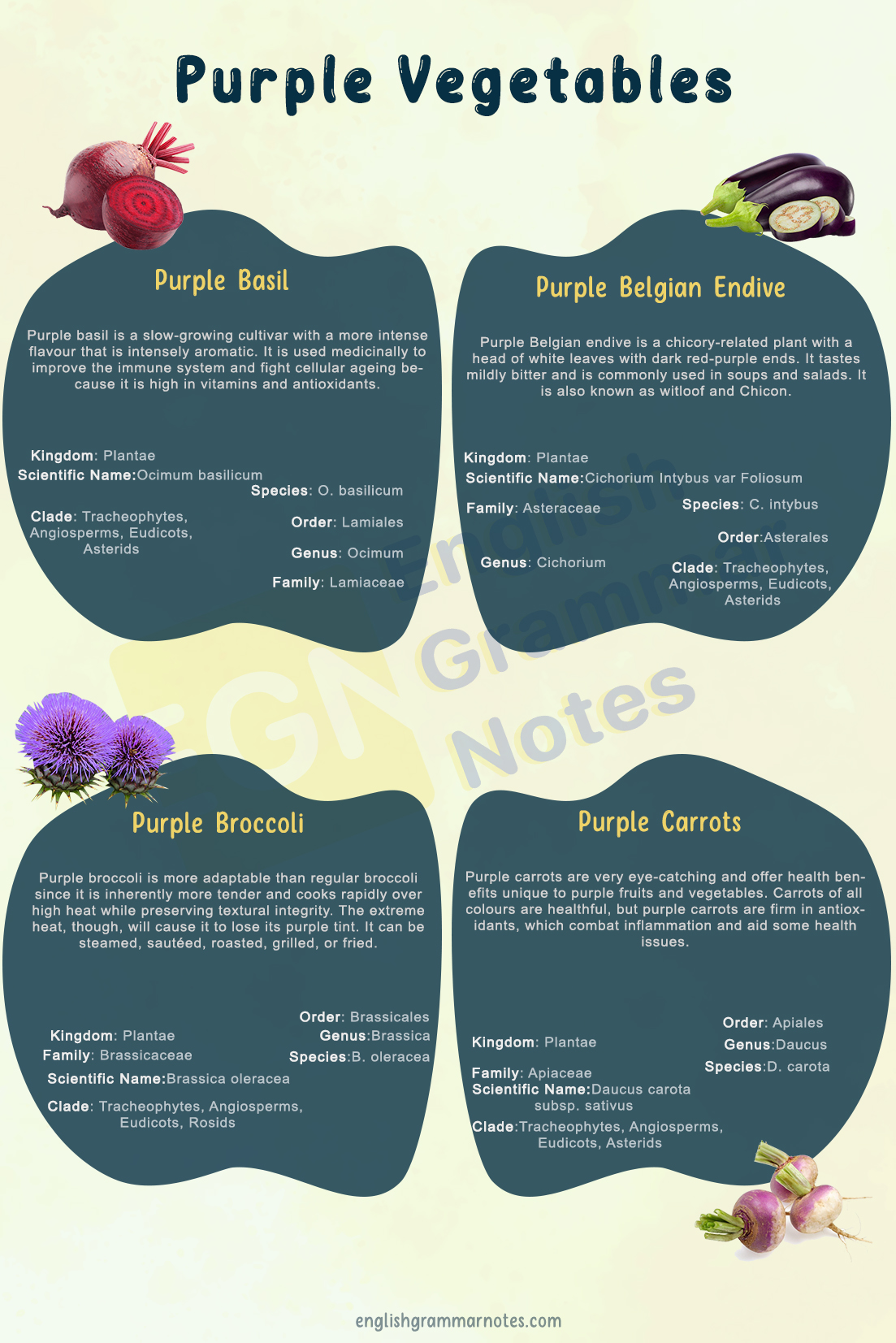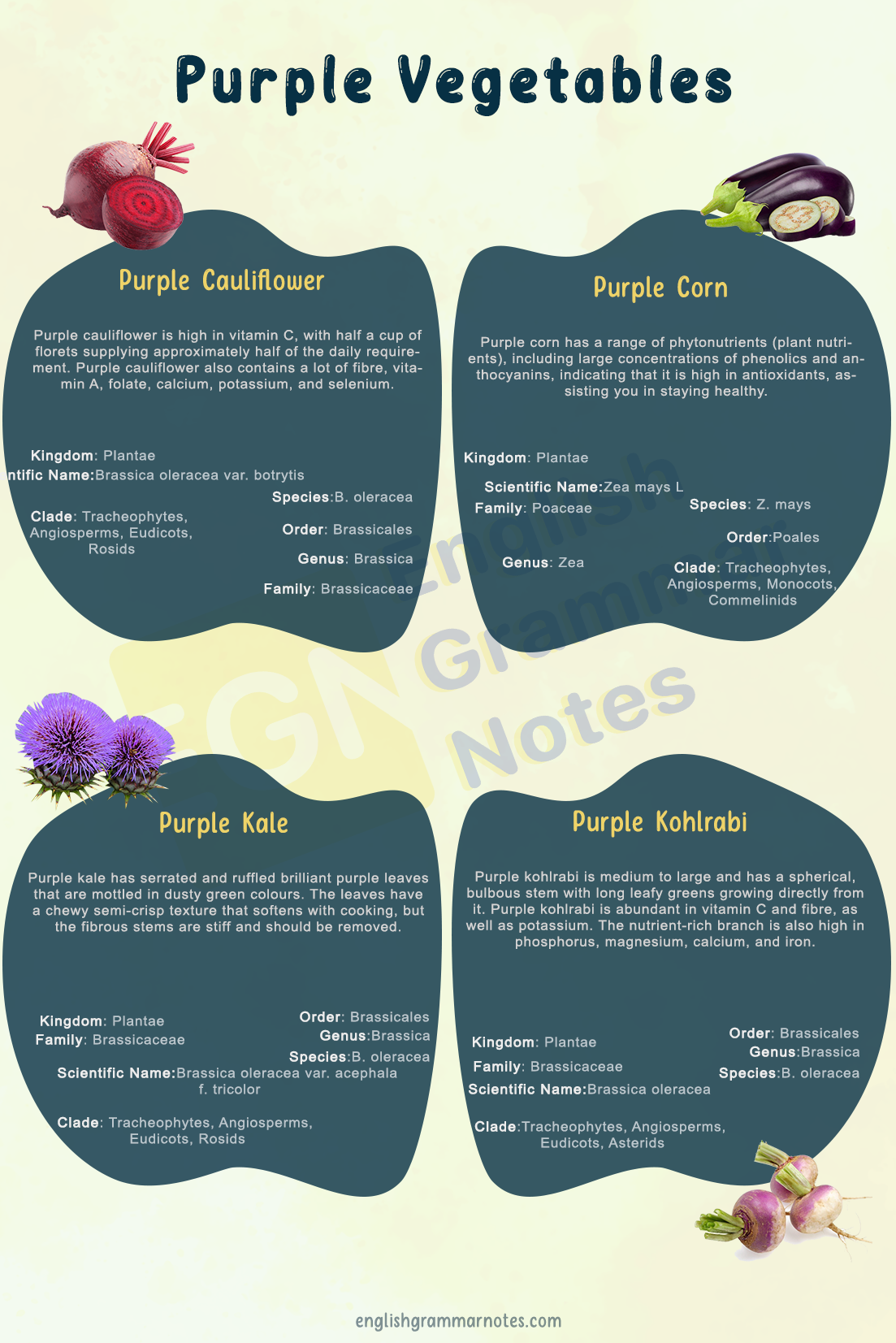Purple Vegetables: Purple foods, particularly purple vegetables, are sought after by health-conscious consumers and those in the know due to their brilliant colour, which suggests a naturally high level of health-promoting antioxidants. From purple potatoes to the tried-and-true red cabbage, this list of purple veggies has plenty of nutritious credentials behind the brilliant hues; they are not only a fantastic way to add colour to a dish, but they should also make you feel good about eating them.
Are you tired of eating the same greenish, pale-looking vegetables? Do you want to switch to some more colourful vegetables without compromising on taste and nutrition? Well, worry not, because here is a list of purple vegetables that will help you add some new veggies to the list of items you have in your diet.
Study the most important English Vocabulary Words identified by our experts and learn the right vocabulary to use in your day to day conversations
List of Purple Vegetables
Names of Purple Vegetables
- Beetroot
- Eggplants
- Prunes
- Purple Artichokes
- Purple Asparagus
- Purple Basil
- Purple Belgian Endive
- Purple Broccoli
- Purple Carrots
- Purple Cauliflower
- Purple Corn
- Purple Kale
- Purple Kohlrabi
- Purple Pepper
- Purple Potato
- Purple Snowpea
- Purple Sweet potatoes
- Purple Thyme
- Radicchio
- Red Cabbage
- Red Leaf Lettuce
- Red Onions
- Ube
Description of the Purple Vegetables
Beetroot
Beetroot is a nutrient-dense vegetable high in vitamins, minerals, and antioxidants. And, as if that weren’t enough, it’s also low in fat. Beetroot is also excellent in haute cuisine.
| Kingdom | Plantae |
| Clade | Tracheophytes, Angiosperms, Eudicots |
| Order | Caryophyllales |
| Family | Amaranthaceae |
| Genus | Beta |
| Species | B. Vulgaris |
| Scientific Name | Beta vulgaris |
Eggplants
Eggplants are versatile purple vegetables that you can consume in a variety of ways. They are high in vitamins, minerals, and dietary fibre, and they can decrease cholesterol and help with weight management.
| Kingdom | Plantae |
| Clade | Tracheophytes, Angiosperms, Eudicots, Asterids |
| Order | Solanales |
| Family | Solanaceae |
| Genus | Solanum |
| Species | S. melongena |
| Scientific Name | Solanum melongena |
Purple Artichokes
This popular vegetable’s purple variation retains its brilliant colour when cooked and is valued for having a slightly more pronounced nutty flavour than its green globe cousin. When served, the rich purple offers an unexpected pop of colour.
| Kingdom | Plantae |
| Clade | Tracheophytes, Angiosperms, Eudicots, Asterids |
| Order | Asterales |
| Family | Asteraceae |
| Genus | Cynara |
| Species | C. cardunculus |
| Scientific Name | Cynara scolymus |
Purple Asparagus
Purple asparagus is high in minerals, vitamins, and phytochemicals. It’s also a good source of anthocyanins. This form of asparagus also contains the most rutin, a plant pigment that may have anti-cancer and heart-protective qualities.
| Kingdom | Plantae |
| Clade | Tracheophytes, Angiosperms, Monocots |
| Order | Asparagales |
| Family | Asparagaceae |
| Genus | Asparagus |
| Species | A. officinalis |
| Scientific Name | Asparagus officinalis |

Purple Basil
Purple basil is a slow-growing cultivar with a more intense flavour that is intensely aromatic. It is used medicinally to improve the immune system and fight cellular ageing because it is high in vitamins and antioxidants.
| Kingdom | Plantae |
| Clade | Tracheophytes, Angiosperms, Eudicots, Asterids |
| Order | Lamiales |
| Family | Lamiaceae |
| Genus | Ocimum |
| Species | O. basilicum |
| Scientific Name | Ocimum basilicum |
Purple Belgian Endive
Purple Belgian endive is a chicory-related plant with a head of white leaves with dark red-purple ends. It tastes mildly bitter and is commonly used in soups and salads. It is also known as witloof and Chicon.
| Kingdom | Plantae |
| Clade | Tracheophytes, Angiosperms, Eudicots, Asterids |
| Order | Asterales |
| Family | Asteraceae |
| Genus | Cichorium |
| Species | C. intybus |
| Scientific Name | Cichorium Intybus var Foliosum |
Purple Broccoli
Purple broccoli is more adaptable than regular broccoli since it is inherently more tender and cooks rapidly over high heat while preserving textural integrity. The extreme heat, though, will cause it to lose its purple tint. It can be steamed, sautéed, roasted, grilled, or fried.
| Kingdom | Plantae |
| Clade | Tracheophytes, Angiosperms, Eudicots, Rosids |
| Order | Brassicales |
| Family | Brassicaceae |
| Genus | Brassica |
| Species | B. oleracea |
| Scientific Name | Brassica oleracea |
Purple Carrots
Purple carrots are very eye-catching and offer health benefits unique to purple fruits and vegetables. Carrots of all colours are healthful, but purple carrots are firm in antioxidants, which combat inflammation and aid some health issues.
| Kingdom | Plantae |
| Clade | Tracheophytes, Angiosperms, Eudicots, Asterids |
| Order | Apiales |
| Family | Apiaceae |
| Genus | Daucus |
| Species | D. carota |
| Scientific Name | Daucus carota subsp. sativus |

Purple Cauliflower
Purple cauliflower is high in vitamin C, with half a cup of florets supplying approximately half of the daily requirement. Purple cauliflower also contains a lot of fibre, vitamin A, folate, calcium, potassium, and selenium.
| Kingdom | Plantae |
| Clade | Tracheophytes, Angiosperms, Eudicots, Rosids |
| Order | Brassicales |
| Family | Brassicaceae |
| Genus | Brassica |
| Species | B. oleracea |
| Scientific Name | Brassica oleracea var. botrytis |
Purple Corn
Purple corn has a range of phytonutrients (plant nutrients), including large concentrations of phenolics and anthocyanins, indicating that it is high in antioxidants, assisting you in staying healthy.
| Kingdom | Plantae |
| Clade | Tracheophytes, Angiosperms, Monocots, Commelinids |
| Order | Poales |
| Family | Poaceae |
| Genus | Zea |
| Species | Z. mays |
| Scientific Name | Zea mays L |
.
Purple Kale
Purple kale has serrated and ruffled brilliant purple leaves that are mottled in dusty green colours. The leaves have a chewy semi-crisp texture that softens with cooking, but the fibrous stems are stiff and should be removed.
| Kingdom | Plantae |
| Clade | Tracheophytes, Angiosperms, Eudicots, Rosids |
| Order | Brassicales |
| Family | Brassicaceae |
| Genus | Brassica |
| Species | B. oleracea |
| Scientific Name | Brassica oleracea var. acephala f. tricolor |
Purple Kohlrabi
Purple kohlrabi is medium to large and has a spherical, bulbous stem with long leafy greens growing directly from it. Purple kohlrabi is abundant in vitamin C and fibre, as well as potassium. The nutrient-rich branch is also high in phosphorus, magnesium, calcium, and iron.
| Kingdom | Plantae |
| Clade | Tracheophytes, Angiosperms, Eudicots, Rosids |
| Order | Brassicales |
| Family | Brassicaceae |
| Genus | Brassica |
| Species | B. oleracea |
| Scientific Name | Brassica oleracea |

Purple Pepper
The Purple Bell Pepper is a 24″ tall, ever-bearing plant that produces peppers that mature from light green to white and then develop purple stripes that cover the entire fruit. The lovely purple exterior contrasts wonderfully with the lime green flesh, and they’re pretty appealing in a salad.
| Kingdom | Plantae |
| Clade | Tracheophytes, Angiosperms, Eudicots, Asterids |
| Order | Solanales |
| Family | Solanaceae |
| Genus | Capsicum |
| Species | C. annuum |
| Scientific Name | Capsicum annuum |
Purple Snowpea
Purple snow peas are high in vitamin C, which helps to boost the immune system, protect cells from free radical damage, and reduce inflammation. The peas also include fibre, which helps regulate the digestive tract, and anthocyanins, which are responsible for the pod’s brilliant color and anti-inflammatory qualities.
| Kingdom | Plantae |
| Clade | Tracheophytes, Angiosperms, Eudicots, Rosids |
| Order | Fabales |
| Family | Fabaceae |
| Genus | Pisum |
| Species | P. sativum |
| Scientific Name | Pisum sativum |
Purple Sweet potatoes
Sweet potatoes are nutritious in and of themselves, providing a variety of minerals and vitamins such as provitamin A, vitamin C, B vitamins, and potassium. Purple potatoes have an added benefit in that they contain anthocyanin antioxidants.
| Kingdom | Plantae |
| Clade | Tracheophytes, Angiosperms, Eudicots, Asterids |
| Order | Solanales |
| Family | Convolvulaceae |
| Genus | Ipomoea |
| Species | I. batatas |
| Scientific Name | Dioscorea alata |
Purple Thyme
Thyme herb is high in phytonutrients (plant-derived compounds), minerals, and vitamins, all of which are beneficial to one’s general health. Thyme includes several active principles that have been shown to have disease-fighting and health-promoting qualities.
| Kingdom | Plantae |
| Clade | Tracheophytes, Angiosperms, Eudicots, Asterids |
| Order | Lamiales |
| Family | Lamiaceae |
| Genus | Thymus |
| Species | T. serpyllum |
| Scientific Name | Thymus serpyllum |
Red Cabbage
Red cabbage, often known as purple cabbage, is another fantastic purple vegetable high in antioxidants, nutrients, vitamins, minerals, and dietary fibre. Red cabbage is a type of cabbage that is also known as Blaukraut when it has been prepared. Its leaves are a dark red/purple tint. However, due to an anthocyanin pigment, the plant’s colour changes depending on the pH of the soil.
| Kingdom | Plantae |
| Clade | Angiosperms, Eudicots, Rosids |
| Order | Brassicales |
| Family | Brassicaceae |
| Genus | Brassica |
| Species | B. oleracea |
| Scientific Name | Brassica oleracea var. capitata f. rubra |
Red Leaf Lettuce
Red Leaf lettuce grows in an elongated shape with a narrow base that fans out to a broad, curly, loose top and is small to medium in size. Red Leaf lettuce contains vitamins A, C, and K and calcium, iron, and anthocyanins, which are antioxidants with anti-inflammatory qualities.
| Kingdom | Plantae |
| Clade | Tracheophytes, Angiosperms, Eudicots, Asterids |
| Order | Asterales |
| Family | Asteraceae |
| Genus | Lactuca |
| Species | L. Sativa |
| Scientific Name | Lactuca sativa |
Red Onions
Red onions range in size from small to medium and have around to slightly oval forms. Vitamin C, fibre, iron, and calcium are all found in red onions. They also have a high polyphenol and flavonoid content, including a lot of quercetin, which has antioxidant characteristics that help with overall health, and sulphur, which helps with anti-inflammatory processes in the body.
| Kingdom | Plantae |
| Clade | Tracheophytes, Angiosperms, Monocots |
| Order | Asparagales |
| Family | Amaryllidaceae |
| Genus | Allium |
| Species | A. cepa |
| Scientific Name | Allium cepa |
Ube
This purple yam is a popular ingredient in both savoury and sweet Filipino recipes. Carbohydrates, copper, vitamins B6 and C, and potassium are all abundant in ube. They also have folate, calcium, and protein, calcium, iron, phosphorus, and a trace of vitamin A.
| Kingdom | Plantae |
| Clade | Tracheophytes, Angiosperms, Monocots |
| Order | Dioscoreales |
| Family | Dioscoreaceae |
| Genus | Dioscorea |
| Species | D. alata |
| Scientific Name | Dioscorea alata |